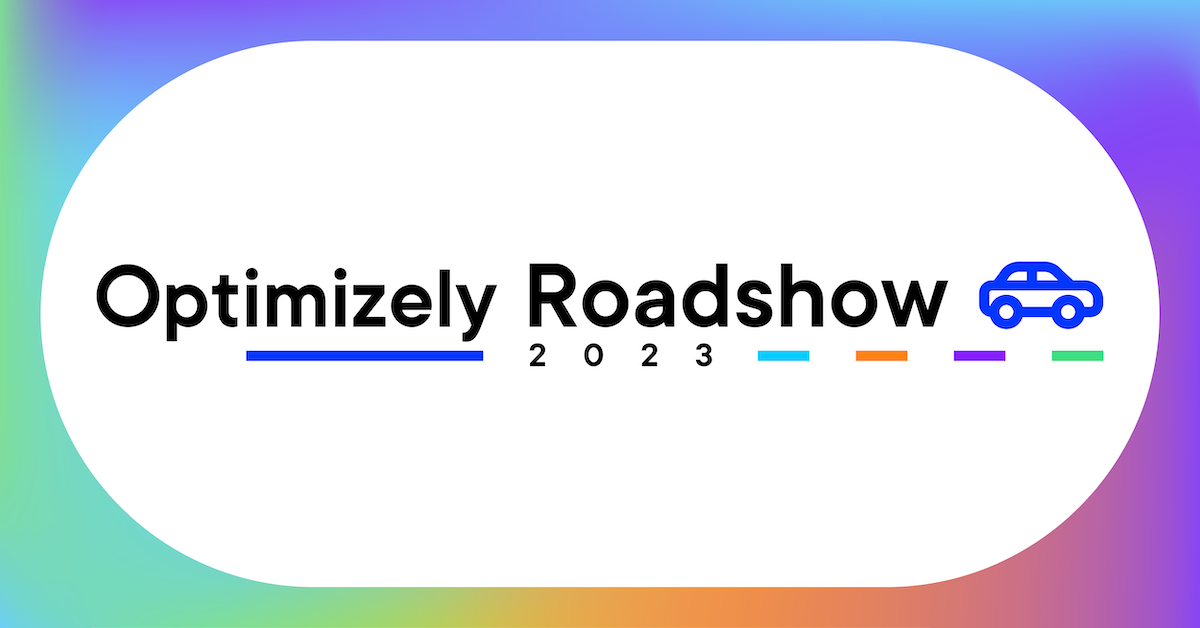Eine Zusammenfassung von Optimizelys Nachmittag in NYC: KI + Personalisierung, Skalierung von Experimenten und Best Practices für Inhalte


Kunden, Interessenten und Partner trafen sich letzte Woche im Flatiron District in New York City zur letzten Station der Optimizely Roadshow, die durch mehrere Städte führte. Von Kunden wie Birkenstock, Bloomberg, Baked by Melissa, Verisk und AMEX bis hin zum Partnersponsor Valtech und seinem besonderen Gast, Arterra Wines, war es ein Nachmittag voller neuer Inhalte, zukunftsorientierter Gespräche und (natürlich) einer Networking-Happy-Hour auf dem Dach in der Frühlingssonne. Für den Fall, dass Sie es verpasst haben, hier die vier wichtigsten Erkenntnisse aus dem Big Apple Event.
1. Personalisierung steht im Mittelpunkt
Nach einer herzlichen Begrüßung durch CEO Alex Atzberger betrat CMO Shafqat Islam die Bühne und eröffnete die Veranstaltung mit einer Keynote, die der Personalisierung gewidmet war und in der er aufzeigte, dass die Erwartungen an maßgeschneiderte Erlebnisse heute höher sind als je zuvor. Personalisierung ist nicht länger ein Wunschtraum oder ein ehrgeiziges Ziel, sie ist jetzt der grundlegende Standard, wenn Verbraucher mit Marken interagieren.
"Wir sind viel offener und bereit, mit unseren persönlichen Online-Daten einen Kompromiss einzugehen, um ein besseres, maßgeschneidertes Erlebnis zu erhalten", sagt Islam. Aber er fährt mit einer wichtigen Erinnerung fort: "Digitale Beziehungen sind immer noch menschliche Beziehungen. Es handelt sich nicht nur um einen Datenpunkt. Es handelt sich um eine echte Person, die diesen Tausch vornimmt, also müssen wir ihr im Gegenzug etwas Wertvolles bieten.
Es ist eine große Chance für Vermarkter, eine tiefere Beziehung zu Kunden über alle Geräte und Berührungspunkte hinweg aufzubauen, so Islam. Und die rasche Einführung von KI ermöglicht uns den neu entdeckten Luxus, Inhalte in rekordverdächtiger Menge und Geschwindigkeit zu erstellen, ohne Abstriche bei der Qualität zu machen.
2. Experimentieren: Unternehmenskultur, Produktübernahme und Kommunikation
Berichterstattung über relevante Experimentiermetriken
Ein Kommentar eines Kunden aus dem Publikum während der abschließenden Podiumsdiskussion machte deutlich, wie wichtig es ist, bei der Berichterstattung über die Ergebnisse von Experimenten an die Unternehmensleitung taktisch vorzugehen. Der Teilnehmer, ein Power-User von Experimentation, meinte, dass die Geschwindigkeit in Bezug auf die Anzahl der Experimente zwar großartig sei, aber nicht unbedingt eine ideale Methode, um den Wert für die Führungsebene zu kommunizieren. Stattdessen müssen wir über die Auswirkungen auf das Geschäft sprechen und die Konversation von "wir haben in diesem Quartal X Experimente durchgeführt" auf "unser Experimentierprogramm hat sich direkt auf den Umsatz um X Prozent ausgewirkt" verlagern. So wird die Zustimmung der Führungskräfte weiter gestärkt, und der darauf folgende Kulturwandel ist eine direkte Folge dieser Unterstützung.
Entscheidungen mit anderen Stakeholdern kommunizieren
Ähnlich äußerte sich auch Michiel Dorjee in seinem Workshop Thinking in digital experiences : "Es ist genauso wichtig, andere Menschen in Ihre Arbeit einzubeziehen, wie Änderungen und Aktualisierungen vorzunehmen", sagt er, "Sprechen Sie darüber, was Sie tun und warum Sie es tun. Holen Sie die Leute an Bord, um die Probleme der Nutzer und die Probleme, die Sie beheben, zu erklären", sagt er. Von Metriken und Experimenten bis hin zu Website-Aktualisierungen und Design - Sie müssen in der Lage sein, Ihre Arbeit intern zu verkaufen. Wenn Sie das nicht vermitteln können, wird Ihre Kultur auf der Strecke bleiben.
Skalierung Ihres Experimentierprogramms
Auf der Veranstaltung wurde viel über die erfolgreiche Skalierung von Experimentierprogrammen und die Möglichkeit, so viele gleichzeitige Tests durchzuführen, wie das Herz begehrt, geredet. Alek Toumert behandelt in seinem Workshop genau dieses Thema, wobei der Schwerpunkt auf dem Übergang von der ersten Ausführung zu einer gefestigten Experimentierkultur liegt, die das gesamte Unternehmen durchdringt. Zu den wichtigsten Gewohnheiten einer experimentierfreudigen Kultur gehören seiner Meinung nach die Festigung der Arbeitsabläufe von Anfang an, die Ausrichtung der Teams auf die richtigen Messgrößen und das Feiern aller Erfolge, Niederlagen und nicht eindeutigen Ergebnisse.
Angesichts der Silos in den Teams, der Bürokratie und der Schwierigkeit, die Zustimmung des Unternehmens zu erlangen, ist die Akzeptanz nicht unbedingt eine Frage der Robustheit des Tools oder der Funktionen, sondern vielmehr der Disziplin, mit der jedes Unternehmen das Tool einsetzt. Der Kulturwandel muss von der Organisation ausgehen, die im Voraus einen Plan aufstellen muss, sonst werden die Tools - und ihr Wert - nur zu einem Nebenprodukt der verlorenen Verfahren und des Managements.
3. Pflege und Investition in Ihre Content-Engine
Shafqat berichtet über die Content-Engine der nächsten Generation: "Die besten Content-Vermarkter sind diejenigen, die über eine gewisse operative Wiederholbarkeit bei der Ideenfindung, Planung, Veröffentlichung und Verbesserung verfügen", sagt er. Investitionen in das Volumen der Inhalte und die Nachhaltigkeit des Prozesses sind das, was den Motor am Laufen hält. Anschließend gehen wir auf einige Best Practices und Erkenntnisse ein:
- Kreativität und Innovation sind ein Teamprozess: Sie müssen es ermöglichen, dass Ideen aus dem gesamten Unternehmen einfließen können, mit einem offenen, konsistenten und bekannten Ort, um Ideen zu erfassen, die später miteinander verbunden werden könnten.
- Inhalte sollten wiederverwendbar sein: Vermarkter sollten Inhalte mit Blick auf die verschiedenen Formen und Kanäle erstellen, für die sie geeignet sind. Testen Sie Variablen wie Länge, Qualität, Stil und CTA-Stärke, um herauszufinden, welche Inhalte bei Ihrer Zielgruppe am besten ankommen.
- Denken Sie über herkömmliche Websites hinaus: Wenn Sie die Inhalte in Ihrem CMS richtig organisieren, ermöglicht eine Headless-CMS-Architektur die einmalige Erstellung von Inhalten und deren Weiterleitung an mehrere verschiedene Kanäle, so dass Sie Ihre Zielgruppe an den von ihr am häufigsten genutzten Touchpoints erreichen.
4. Die Produkt-Roadmap von Optimizely
Reden ist schön und gut, aber wie gehen wir in die Praxis? Unsere Kunden wollen nicht nur über die Prinzipien der Technologie plaudern, sie wollen sich auch die Hände schmutzig machen mit realen Anwendungen auf der Ebene der Praktiker. Jeff Cheal erläuterte die Highlights der Optimizely-Roadmap für den Rest des Jahres 2023, die laserfokussierte Innovationen in drei Schlüsselbereichen umfasst, wobei einige (von vielen) zu erwartende Aktualisierungen unten aufgeführt sind.
- Ein einheitliches Benutzererlebnis mit zentraler Einzelanmeldung (voraussichtlich in Q3): In einem Klima, in dem unsere Kunden ihre Budgets einschränken und ihre Ausgaben für Technologie reduzieren, ist es von entscheidender Bedeutung, dass die von ihnen verwendeten Tools nahtlos zusammenarbeiten. Echte Investitionen in die Vereinheitlichung unserer Produktsuite senken nicht nur die Betriebskosten und die Entwicklungsanforderungen, sondern schaffen auch ein optimiertes Benutzererlebnis und vereinfachen die Benutzerverwaltung.
- KI und bessere Arbeitsweisen: Wir integrieren KI in alles, was wir tun, und Sie finden unseren KI-Inhaltsgenerator jetzt in den operativen CMP-Workflows, in denen Teams bereits zusammenarbeiten. Sie können Inhalte, Blogposts, Schlagzeilen und Bilder generieren und die Kreativität direkt im Produkt selbst anregen.
- Targeting und Experimente der nächsten Stufe: Eine spannende Ankündigung einer neuen Integration zwischen Optimizely Web Experimentation und Google Analytics 4 bedeutet, dass Benutzer tiefere Einblicke in die Interaktion ihrer Besucher mit ihrer Website erhalten, was zu wirkungsvolleren Experimenten und Optimierungen führt. Wir bereiten uns auch auf Advanced Audience Targeting vor (voraussichtlich in Q3), das die native Optimizely ODP verbinden wird, um die Verwendung bestehender Segmente für Omnichannel-Experimente, Personalisierung und Feature-Management zu ermöglichen.
